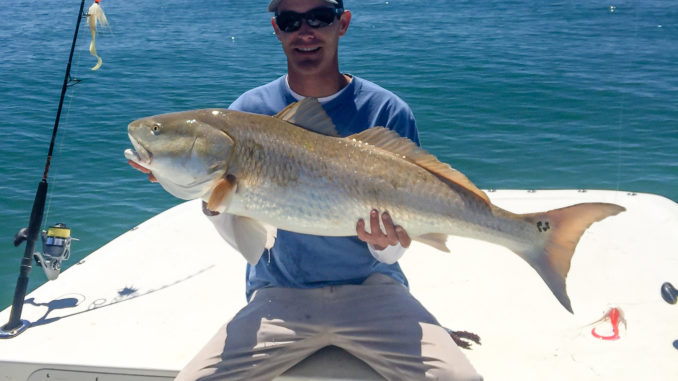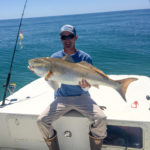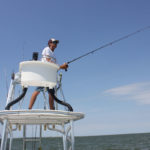
The areas inshore of Hatteras and Ocracoke inlets fill up with some hefty red drum this month as fish begin to move back toward the ocean.
The mouth of the Neuse River and the western Pamlico Sound aren’t the only places to hook into a trophy red drum this month. Massive schools of the bronzed beasts still haunt Hatteras and Ocracoke Inlets, where they entered the estuary last spring after a long winter at sea.
While the western side of Pamlico Sound has gained notoriety for the size of the gathering, the clear waters of the Outer Banks grant a special opportunity to anglers: sight-casting to schools of mature reds that number in the hundreds.
“Schools of 300 to 600 big ones are not uncommon,” said Rom Whitaker IV of Sound Bound Charters in Hatteras. “I’ve seen up to 700 or 800 in a school, big drum. I’ve seen them from an airplane as well; I know that they’re there.”
Despite the availability of the target, it takes more than a passing glance to identify even an enormous school of red drum. Whitaker perches atop a tower on his skiff, a vantage point close to 15 feet above the deck with steering and throttle to allow him operation from above. Keen eyesight, paired with polarized sunglasses, make unblinking passes over the surface until blips appear on his God-given radar.
“It seems like a lot of times they’re in deeper water,” Whitaker said, “but when they want to feed, they’ll go up on the flats in 3 to 5 feet of water and spend a couple of hours staging around good numbers of bait. Between 9 and 3 o’clock is the time I like to sight-fish, simply for the fact that I can see better. Within 1 to 2 miles inside of Hatteras and Ocracoke Inlets are great places to look. In August, they start making their way back closer to the inlets and stay there until it cools off.”
An aerial view of the areas behind both inlets reveals an extensive network of sloughs and flats, prime places for predators to stay in deeper waters and quickly transition to the shallows where unwitting pods of bait can be corralled more easily.
“Most of the time, that golden bronze in the water is what I actually see,” he said, “but, they do get up on top. They could be a quarter-mile away, and you can see 30 or 40 of them tearing up baitfish. You can see whitewater flying, and it looks like a school of albacore, but it’s 50-pound drum.”
Despite the adrenaline pumping when he spots a school, Whitaker’s approach is to play it cool, and ease into range as quietly as possible. If the school is spooked, it’s game over. Cutting his motor and gliding to the edge of opportunity, he instructs anglers to avoid heavy foot traffic that would alert fish to their presence as they scramble to the bow while he advises casting direction from his bird’s-eye view.
“Placement is everything,” Whitaker said. “If it’s a big school, I’m just trying to get them to land it front and center. But a 3 ounce bucktail going down through them does tend to freak them out a bit. If that’s what we’re throwing, we’ll cast it past them or to one side, whichever way the school is leading.”
One of Whitaker’s favorite lures is a ¾-ounce Johnson Silver Minnow weedless spoon or a ¾- to 2-ounce Hopkins spoon, which are subject to be tossed right in the heart of the stampede.
“When those spoons hit the middle of the school, they don’t sink nearly as fast as a jig,” said Whitaker. “By the time you get it tight and doing what it’s supposed to do, there’s usually two or three of them trying to eat it. But you got to cast it right in the meat or you’re not going to get one. If I see one of my anglers cast it out there and he misses the school, I’m instantly telling him to reel it back to the boat and make another cast.”
Once an angler is hooked up, Whitaker pulls a trick from his hat often used by offshore anglers targeting dolphin to get everyone in on the action.
“If you let that first fish pull a little line off, don’t heave on him real hard, and kind of hold him there hooked. That school of fish will stay right there,” he said. “An F5 Tornado is what we call them when they do that circle. They’ll stay right around the boat with the motor off, and you could literally hook 10 if you had anglers for it.
“We hooked four triple-headers on a charter last year, caught all 12 in about 40 minutes, and went about our business. But that takes a lot of talking to each other to keep from tangling up.”
DESTINATION INFORMATION
HOW TO GET THERE — The village of Hatteras is at the southern end of Hatteras Island on NC 12, which can be accessed in Nags Head from US 64 and all parts west. The village of Ocracoke is at the southwest end of Ocracoke Island, which is accessed via Ferry across Hatteras Inlet or via ferry from Swanquarter or Cedar Island.
WHEN TO GO — Big red drum gang up just outside of Hatteras and Ocracoke inlets in May and June before they head across the Pamlico Sound to spawn. In August, a healthy population can be found a few miles behind the inlets, moving closer as the month progresses, ready to head back to the ocean when the weather cools in the fall.
BEST TECHNIQUES — For bottom-fishing during low-light conditions, use medium-heavy spinning tackle, 7 to 7½ foot rods and 6000 to 8000 series spinning reels spooled with 80-pound braid with an 8- to 16-inch leader of 60- to 80-pound fluorocarbon. Chunks of fresh mullet or menhaden should be pinned to a 7/0 to 8/0 circle hook with 4 to 8 ounces of lead on a fish-finder rig. Fishing cut bait between 7 p.m. and 7 a.m., fishermen are required to use a leader 6 inches or shorter and a crimped weight at the swivel. For sight-casting, medium-action rods from 7 to 71/2 feet with 4000 or 5000 series reels are best, spooled with 10- to 20-pound braid and 2 feet of 20-pound fluorocarbon leader. A 3/4-ounce gold Johnson spoon or a 3/4- to 2-ounce Hopkins spoon are good choices, along with a 3-ounce Meat Hog jig or a white jig with a 3- to 4-inch soft-plastic, curlytail trailer.
FISHING INFO/GUIDES — Rom Whitaker IV, Sound Bound Charters, 252-305-5229; Hatteras Harbor Marina, 252-986-2166. See also Guides and Charters in Classifieds.
ACCOMMODATIONS — The Breakwater Inn, Hatteras, 877-986-2565; Village Marina Motel, Hatteras, 252-986-2522; Outer Banks Chamber of Commerce, 800-627-3160, www.outerbankschamber.com.
MAPS — GMCO’s Chartbook of North Carolina, www.gmcomaps.com; Capt. Segull’s Nautical Charts, 888-473-4855, www.captainsegullcharts.com; Sealake Fishing Guides, 800-411-0185, www.thegoodspots.com.





Be the first to comment